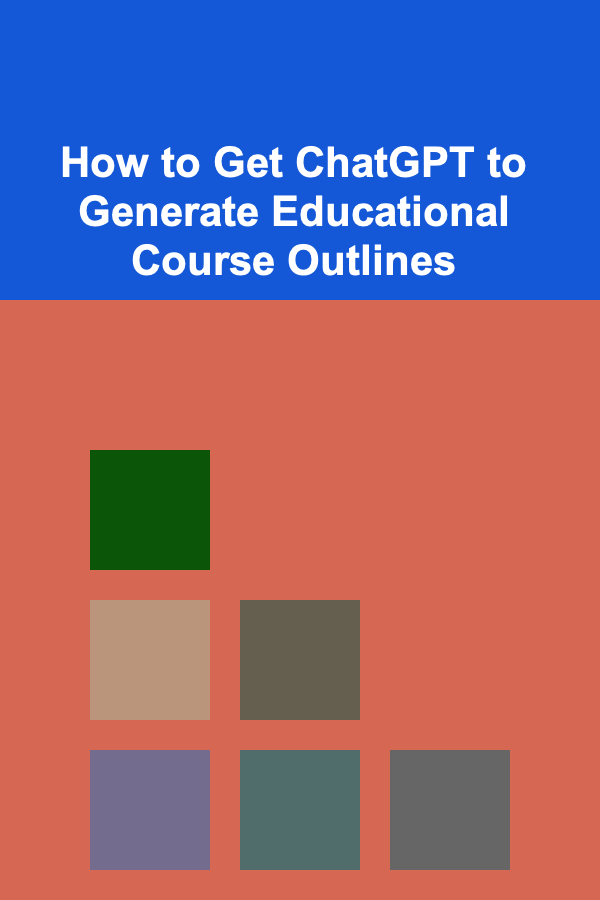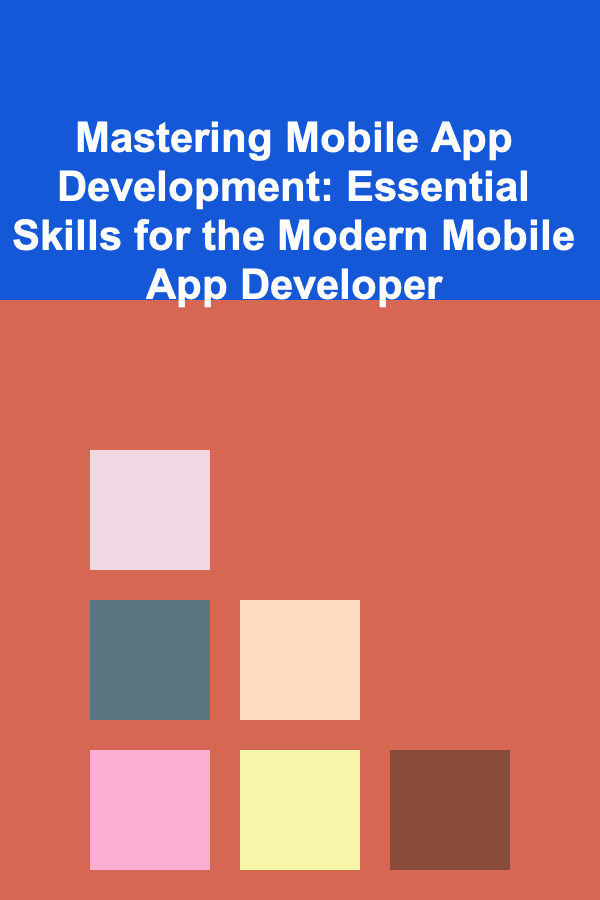
How to Get ChatGPT to Generate Educational Course Outlines
ebook include PDF & Audio bundle (Micro Guide)
$12.99$8.99
Limited Time Offer! Order within the next:

Creating an educational course outline can be a challenging task, requiring a thoughtful structure and detailed content. Whether you're an educator designing a new course, a curriculum developer looking for ideas, or a student wanting to create study guides, ChatGPT can be a helpful tool to assist in this process. Leveraging its advanced language generation capabilities, ChatGPT can help craft outlines that are comprehensive, well-organized, and engaging. This article will guide you on how to effectively use ChatGPT for generating educational course outlines.
Understanding the Power of ChatGPT for Course Design
Before diving into the specifics of how to generate educational course outlines, it's important to understand what ChatGPT brings to the table. ChatGPT is a large language model that can generate human-like text based on the prompts given. It can assist in a variety of ways, including helping to structure educational content, offering learning objectives, providing suggestions for reading materials, and even coming up with assignments.
By using ChatGPT to generate educational course outlines, you can save time, gather diverse ideas, and benefit from the model's ability to synthesize information from various sources. With its ability to understand and process prompts in a detailed manner, ChatGPT can provide nuanced responses, making it an invaluable tool for educators and curriculum developers alike.
Steps to Get ChatGPT to Generate Educational Course Outlines
1. Define the Scope and Topic
The first step in using ChatGPT to generate an educational course outline is to define the scope and topic of your course. The more specific you are with your prompt, the better the results will be. A vague request will yield a more general outline, while a detailed and specific prompt will result in a tailored and focused course structure.
Example Prompt:
- "Create a course outline for a high school biology class focusing on cell biology, including key topics such as cell structure, cell division, and cellular respiration."
- "Design an online course outline for adults learning about financial literacy, covering topics such as budgeting, investing, and retirement planning."
Being specific about the course level (e.g., high school, university, adult learners) and key themes will help ChatGPT generate more relevant content. Additionally, think about the goals of the course: Are you aiming for knowledge transfer, skills development, or both?
2. Establish the Course Duration and Format
Next, it's essential to establish the course duration and format. This includes determining how many lessons the course will have, the length of each session, and the overall course timeline. ChatGPT can assist in structuring a course that fits within the allocated time while ensuring comprehensive coverage of the subject matter.
Example Prompts:
- "Create a 10-week course outline for an Introduction to Psychology, with two-hour weekly lessons."
- "Design a weekend workshop course outline on time management for busy professionals."
If the course is designed for a specific duration, such as a few weeks or a semester, ChatGPT can structure the lessons accordingly, ensuring that the content is broken down logically and progressively.
3. Provide Learning Objectives
The learning objectives are a critical component of any course outline. These objectives define what learners should be able to achieve by the end of the course. ChatGPT can help you create clear, concise, and measurable learning objectives that align with the course content.
Example Prompts:
- "Generate 5 learning objectives for a course on renewable energy sources."
- "What are the primary learning outcomes for a course on business communication skills?"
A good set of learning objectives typically follows the SMART criteria (Specific, Measurable, Achievable, Relevant, and Time-bound). These objectives guide the creation of the course materials and ensure that each lesson has a clear purpose.
4. Break Down the Topics and Modules
Once the course's scope, format, and objectives are defined, ChatGPT can help you break down the topics into manageable modules. Each module should cover a specific sub-topic and lead the learner towards the course's overall goals. You can request ChatGPT to suggest specific content for each lesson, including lectures, activities, and resources.
Example Prompts:
- "Provide a breakdown of modules for a 12-week course on Artificial Intelligence, including topics such as machine learning, neural networks, and ethical considerations."
- "Create a lesson plan for a one-hour lecture on the history of the French Revolution."
For each module, ChatGPT can also suggest key readings, multimedia resources (such as videos and podcasts), and practical activities that would reinforce the lesson. This ensures that your course is well-rounded and interactive.
5. Suggest Assessments and Assignments
An essential part of any educational course is assessment. This can be in the form of quizzes, assignments, exams, or project-based evaluations. ChatGPT can help you design assessments that test the learners' understanding and application of the material.
Example Prompts:
- "Generate ideas for quizzes and assignments for a course on Introduction to Philosophy."
- "Suggest a final project for a course on digital marketing."
The types of assessments you design should be aligned with the learning objectives. For instance, if the course aims to develop practical skills, you might opt for project-based assessments. If it's knowledge-based, quizzes or written exams may be more appropriate.
ChatGPT can also assist in creating rubrics for grading, making it easier to evaluate students' work consistently and fairly.
6. Incorporate Feedback and Revision Cycles
It's important to incorporate feedback mechanisms in your course design. ChatGPT can help you outline opportunities for feedback, such as peer reviews, instructor feedback, or self-assessment. You can ask for suggestions on how to structure these feedback loops to foster continuous improvement.
Example Prompts:
- "How can I incorporate mid-course feedback into an online course?"
- "Create a self-assessment questionnaire for learners at the end of each module."
By integrating feedback, you ensure that learners have the chance to reflect on their progress and improve before moving on to more complex material.
7. Consider Learner Engagement Strategies
Finally, keeping learners engaged throughout the course is crucial for successful learning outcomes. ChatGPT can offer suggestions on how to incorporate interactive elements, such as discussion boards, group projects, case studies, and simulations. These elements help learners stay motivated and actively involved in the learning process.
Example Prompts:
- "Suggest ways to engage learners in an online course on project management."
- "How can I make my lectures more interactive and engaging for university students?"
Interactive strategies can enhance the learning experience and encourage students to apply the material to real-world situations, which aids retention and application.
Best Practices for Using ChatGPT in Course Design
1. Be Clear and Specific in Your Prompts
The more detailed your request, the more accurate and relevant the output will be. ChatGPT responds best to specific prompts that clearly outline your needs. If you want a course outline, include information such as the level of the course, key topics, duration, and any other specific requirements.
2. Refine and Iterate
Creating a perfect course outline on the first try might not always be feasible. Don't hesitate to revise and ask follow-up questions to refine the outline further. You can ask ChatGPT to adjust the level of detail, suggest alternative content, or provide more granular breakdowns for individual modules.
3. Use ChatGPT to Supplement Your Expertise
While ChatGPT is an excellent tool for generating ideas and structuring content, always apply your expertise and understanding of the subject matter. Use ChatGPT as a starting point or to brainstorm ideas, but ensure that the final outline aligns with your educational philosophy and teaching style.
4. Leverage ChatGPT's Creativity
ChatGPT can generate creative ideas for teaching methods, assessments, and activities. Feel free to experiment with different types of assignments, course structures, and learning approaches. It can even provide inspiration for multimedia content such as podcasts, videos, and online forums to support the learning process.
Examples of Educational Course Outlines Created Using ChatGPT
Example 1: High School Biology Course
Course Title: Introduction to Biology -- Cell Biology Focus
Duration: 10 weeks
Weekly Sessions: 1.5 hours per session
Learning Objectives:
- Understand the structure and function of cells.
- Explain the processes of mitosis and meiosis.
- Identify the different stages of cellular respiration.
- Analyze the role of enzymes in cellular processes.
Modules:
-
Introduction to Cells
- Key concepts: Cell theory, types of cells, cell organelles
- Activity: Microscope lab examining plant and animal cells
-
Cell Division: Mitosis and Meiosis
- Key concepts: Stages of mitosis, comparison of mitosis and meiosis
- Activity: Animation of cell division process
-
Cellular Respiration
- Key concepts: Glycolysis, Krebs cycle, electron transport chain
- Activity: Model-building of the Krebs cycle
Assessment:
- Mid-term exam on cellular structures and processes
- Final project: Presentation on genetic inheritance and cell division
Example 2: Online Course on Digital Marketing
Course Title: Digital Marketing Essentials
Duration: 6 weeks
Weekly Sessions: 2 hours per session
Learning Objectives:
- Understand the principles of SEO and SEM.
- Create effective social media marketing campaigns.
- Design an email marketing strategy that converts leads.
Modules:
-
Introduction to Digital Marketing
- Key concepts: Overview of digital marketing channels, importance of data analysis
- Activity: Case study analysis of successful digital campaigns
-
Search Engine Optimization (SEO)
- Key concepts: On-page and off-page SEO, keyword research
- Activity: SEO audit of a website
-
Social Media Marketing
- Key concepts: Content creation, audience targeting, analytics
- Activity: Create a content calendar for a brand
Assessment:
- Weekly quizzes on digital marketing tools and concepts
- Final project: Develop a comprehensive digital marketing strategy for a hypothetical business
Conclusion
ChatGPT can be an incredibly useful tool when creating educational course outlines. By following the steps outlined above, you can leverage its capabilities to structure courses that are engaging, comprehensive, and aligned with your educational goals. Whether you are designing a high school class, a professional development workshop, or an online learning program, ChatGPT can help you save time and increase the quality of your course planning. By providing detailed prompts and refining the outputs, you can develop a course outline that meets your specific needs and enhances the learning experience for your students.
Other Products

Beyond Borders: International Expansion Strategies for the Aspiring Business Development Manager
Read More
How to Inspect and Maintain Your Home's Deck or Patio
Read More
How to Make Money Online as a Presentation Designer: 10 Actionable Ideas
Read More
How to Organize Outdoor Equipment for Easy Access
Read More
How to Understand Cryptocurrency Investments for Beginners
Read More